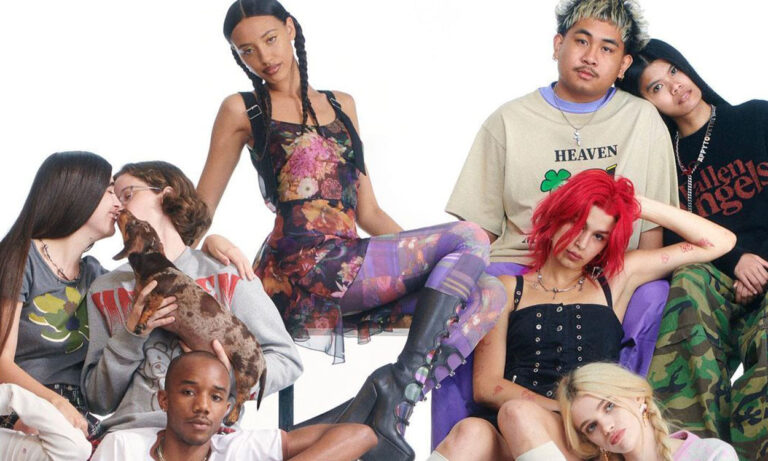Heaven by Marc Jacobs’ collaboration with Won Kar-wai is capitalism at its worse

Heaven, aka the TikTok-obsessed direct-to-consumer line first launched by Marc Jacobs in 2020, recently unveiled its latest capsule which led me to roll my eyes so far back that it almost felt like they were about to pop out of my skull. The new collection is a collaboration with esteemed Hong Kong director Wong Kar-wai, who’s known for melancholy, atmospheric, and non-linear narratives. This collection however is far from vivid.
Rather than honing in on my own personal opinions regarding the collection, let’s focus on the greater issues at hand when it comes to this latest capsule. Most significantly, the casual nature in which Marc Jacobs’ label stole an identity from queer creatives on its way to try and capture youth culture.
Unpacking the Heaven aesthetic and its ripped off brand identity
Heaven’s core aesthetic feels like it’s ripped out of the For You Page (FYP) of the fashion-obsessed youth, albeit not in a good or honest way. For those who might not be familiar with the Heaven omniverse, the brand’s essence is very much inspired by the street style of Harajuku in the 90s, queer collectives, and indie, subversive cinema obsessives with an emphasis on Y2K, grunge, and knitwear.
It’s a style movement I usually enjoy. Aside from an obsession with Harajuku fashion that I’ve nursed since I was a kid, this aesthetic is free flowing, and full of cultural references and influences that I’m attracted to.
View this post on Instagram
While, on the surface, Heaven is pulling from popular themes, the attached overpriced label is inherently subverting its authenticity. The brand is funnelling motifs and tropes from the aforementioned references, but then distilling them down into something trendy and highly commercial. You could easily find most of the types of clothes it sells from thrift stores or independent boutiques, without the hefty designer markup.
The pieces from Heaven are often poorly constructed and use cheaper materials in order to save on manufacturing costs. TikTokers have held nothing back in their critiques of several of the brand’s offerings. Many complained that its pieces were quickly ridden with holes and that the low-quality metal used in Heaven’s jewellery produced a nasty green tinge—festive indeed, huh?
@ ♬ -
The collection is also missing the quintessential luxury edge that you’d expect from fashion giants such as Marc Jacobs and Heaven’s creative director Ava Nirui. Those in the know are fully aware of the label’s lack of integrity when it comes to this, and it seems like netizens are now waking up to its shallowness too.
View this post on Instagram
Quality aside, the most pressing matter when it comes to Heaven’s aesthetic still has to be the fact that it continues to outright steal the brand identity of Los Angeles-based queer collective Heav3n. Self-promoting as a “party in the clouds,” this inclusive space has been a proud pitstop for pop icons—and revered LGBTQIA+ patriots—such as Charli XCX, Kim Petras, and the late SOPHIE.
Heav3n regularly hosted a space for creatives to showcase their clothing. However, after having its identity and curated style pinched by the Marc Jacobs team, it appears that the collective has since stopped selling garments. A YouTube video from online expert FashionLover4 elaborates on this move and details how Lulo, the organiser of the collective, did initially have a conversation with Marc Jacobs himself about the collection. But, as it turns out, the discussion ultimately amounted to nothing.
The fashion commentator urged viewers to research, thrift, and support small designers that have helped propel this particular aesthetic forward rather than inadvertently propping up a company owned by one of the richest men in the world.
Heaven’s latest collection fails to ascend to the clouds
Kar-wai’s 1995 Fallen Angels is a brilliant movie and it’s one I personally hold dear to my heart. The film’s messy, disjointed narrative and engaging character vignettes are stellar. So, despite my distaste for Heaven having grown substantially over the past year, I was still cautiously excited about this collaboration. However, the capsule’s drop quickly dashed those hopeful expectations.
Rather than authentic innovation, we were fed Heaven’s usual bread and butter. Graphic ringer tees adorned with the Fallen Angels logo, sequined tops and skirts, sweater vests with a quote from the film director’s other legendary film Chungking Express, and lacklustre jewellery.
This latest collection is essentially Primark for film snobs and people with access to a weighty credit card. Sterile logos on basic T-shirt patterns that Heaven has used before? This doesn’t look like inspired or valuable work. I’m perfectly capable of enjoying Kar-wai’s films without feeling the need to wear a £335 crewneck.
A Cocteau Twins collaborative drop before this, and a Sofia Coppola one before that—in all honesty, this feels more like glorified merch than an eclectic fashion collective. To its credit, Heaven by Marc Jacobs has had a few collaborations in the past that I’ve liked. For example, its partnership with thrift-focused creative unit Nong Rak earlier this year produced some truly signature fuzzy knitwear, the likes of which sent gen Zers into a feral frenzy.
It’s not to say that the label always misses, but it’s a worrying development to feel as though the brand only succeeds when it’s being carried and curated by an external designer. Heaven has the money and the budget for greatness, it just fails to utilise these assets in a meaningful way. Attaching itself to big names such as Pamela Anderson and Kyle MacLachlan is cool, but this doesn’t go far when their photographic shoots are bland, and the clothing so flat.
Fashion over-consumption aside, all I see when I look at the Heaven by Marc Jacobs editorials and drops is a vampiric drain on youth culture. The garments are a distillation of what it thinks will sell, rather than a championing of niche aesthetics and authentic designs.




